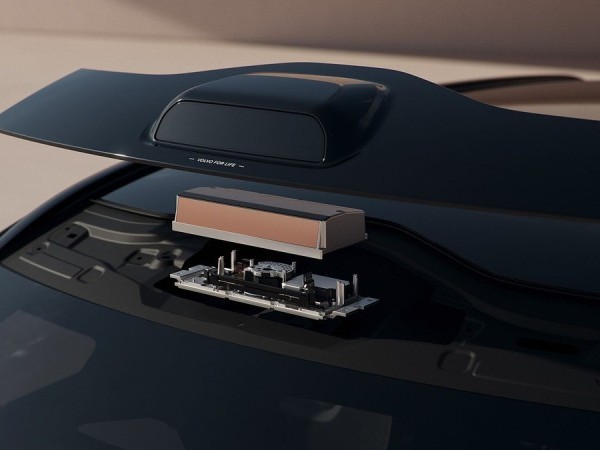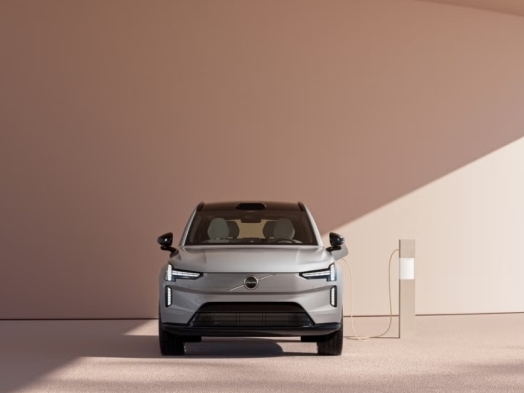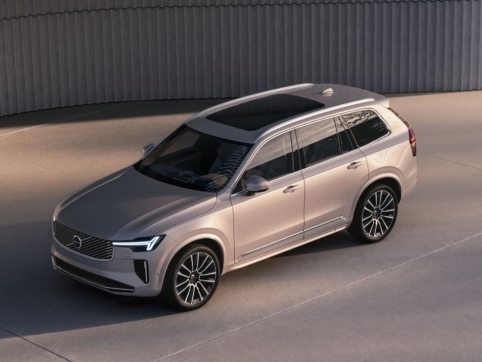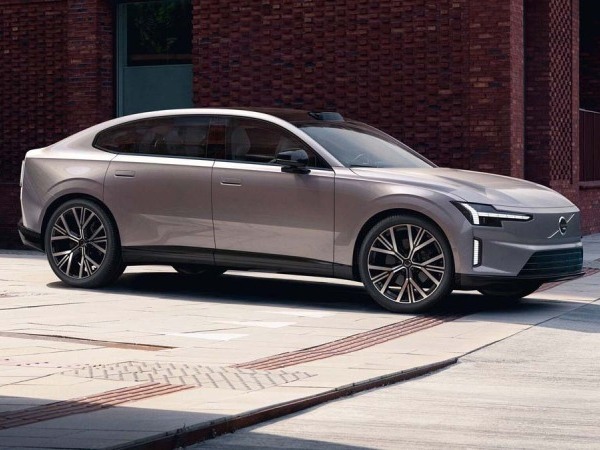Q
What is the top speed of C40?
The top speed of C40 is 180 km/h. As a fully electric compact SUV, its speed capability meets the demands of most driving scenarios. At high speeds, vehicle stability is crucial, and the C40's front MacPherson strut independent suspension and rear multi-link independent suspension system effectively suit the bumpy road, enhancing ride comfort while maintaining stability of the vehicle at high speed.
The braking system is also meticulously tuned, with front ventilated disc brakes and rear solid disc brakes providing reliable stopping power when decelerating from high speeds, ensuring safe and controlled braking. Furthermore, comprehensive safety features—including multiple airbags and electronic stability control—deliver all-around protection for high-speed driving.
Special Disclaimer: This content is published by users and does not represent the views or position of PCauto.
Related Q&A
Q
What kind of battery is in the Volvo C40 2024?
The 2024 Volvo C40, as a fully electric model, packs an advanced lithium-ion battery pack. The exact capacity depends on the trim level, with 78kWh for the standard version and 82kWh for the long-range variant. It utilizes CATL's NCM (Nickel-Cobalt-Manganese) battery technology, which excels in energy density and low-temperature performance – perfect for Malaysia's tropical climate, delivering an estimated WLTP range of around 500 kilometers. It's worth highlighting that Volvo backs the C40's battery with an impressive 8-year or 160,000-kilometer warranty (whichever comes first), offering owners peace of mind for the long haul. For Malaysian users, this range is more than sufficient for daily commutes or intercity getaways. What's more, the C40 supports 150kW DC fast charging, allowing you to juice up from 10% to 80% in approximately 40 minutes. This, combined with the steadily improving local charging infrastructure, makes it a convenient choice. If you're wondering about battery care, a good rule of thumb is to regularly charge within the recommended 20%-80% window to help prolong its lifespan. Also, try to avoid leaving it parked in extreme heat for extended periods. While the battery management system does feature active cooling, sensible usage will go a long way in keeping it performing optimally.
Q
Is the Volvo C40 safe?
The Volvo C40, as a pure electric SUV, carries forward the brand's legendary high safety standards, making it a perfect fit for Malaysian consumers who value both safety and environmental consciousness. Built on the CMA platform, this SUV features a body constructed with high-strength steel and multiple energy-absorbing structures. It comes standard with the City Safety system, which effectively detects pedestrians, cyclists, and large animals. When paired with Pilot Assist, it significantly reduces collision risks, whether you're navigating congested city streets or cruising on the highway.
As an electric vehicle, its battery pack has undergone rigorous fire and collision testing and is equipped with a collision power cut-off protection mechanism. Notably, the C40 achieved a five-star rating in Euro NCAP testing, with particularly impressive performance in side impact protection and AEB (Autonomous Emergency Braking).
For Malaysian users, Volvo has an established after-sales network in major cities like Kuala Lumpur. Additionally, electric vehicles enjoy tax incentives locally, and charging infrastructure is gradually improving. If you're considering an electric model, it's worth comparing the range and charging compatibility with other same level competitors. However, Volvo's heritage and expertise in passive safety technologies and accident prevention systems truly place it at the forefront of the industry.
Q
How much is the Volvo C40 in 2024?
The 2024 Volvo C40 is expected to carry an official price tag in Malaysia ranging from RM250,000 to RM300,000. Of course, the final figure might shift a bit depending on the chosen trim level, any optional extras you throw in, and potential tweaks to tax policies.
As Volvo's pure electric SUV offering, the C40 stays true to the brand's signature Scandinavian design language. Under the skin, it packs a 78kWh battery pack, delivering an estimated WLTP range of around 440 kilometers. Charging-wise, it supports 150kW fast charging, which means you can top it up from 10% to 80% in about 40 minutes.
Malaysian buyers should keep an eye on Volvo Cars Malaysia's official website or authorized dealers for the latest promotions. Things like sales tax exemptions or free charging packages are often on the table.
It's worth noting that the C40 shares the same CMA platform as the XC40 Recharge. However, its sloping fastback roofline helps optimize the drag coefficient to 0.32Cd, which genuinely contributes to improving the electric range.
When stacked up against other luxury electric SUVs in its class, the C40's Thor's Hammer LED headlights and the native Google infotainment system stand out as key differentiators. Additionally, Volvo's growing charging network infrastructure in Malaysia goes a long way in easing any range anxiety for potential owners.
If you're considering a test drive, I'd recommend paying special attention to how you adapt to the one-pedal driving mode. It's one of those unique driving characteristics that defines the Volvo electric experience.
Q
What are the changes in the Volvo C40 in 2024?
The 2024 Volvo C40, the brand's pure electric SUV, focuses its upgrades on range, tech features, and design tweaks. For the Malaysian market, we're looking at a potential battery capacity boost to 82kWh, which should push the WLTP range up to around 500km – a welcome improvement for those longer drives locals often take. On top of that, faster DC charging support means less time twiddling your thumbs at the plug.
Inside, it's that classic Scandinavian minimalism we know, but with a new-gen infotainment system stealing the show. Google services are baked right in – think Maps and voice assistant – and you'll probably get a 12.3-inch digital driver's display and a 9-inch central touchscreen as standard, upping the tech ante nicely.
Outside, there are fresh exclusive wheel designs and paint options to give it a sportier edge. Now, for Malaysian customers, a big focus here is tropical climate adaptability. That means a beefed-up battery thermal management system to keep things stable when the mercury rises. And of course, Volvo's legendary high safety standards aren't going anywhere, complete with the full suite of driver assistance systems.
If you're considering an EV, don't forget to factor in Malaysia's government tax incentives for EVs and how the charging infrastructure is shaping up – both will play a big role in your day-to-day experience. When you're sizing it up against rivals like the Mercedes EQA or BMW iX1, it's all about balancing your budget and what you really need from your ride.
Q
Is the Volvo C40 Recharge being discontinued?
Volvo hasn't officially announced any plans to discontinue the C40 Recharge just yet. The all-electric SUV is still on sale in select markets, though for folks in Malaysia, the best bet is to check with local dealerships for the latest on availability. As a key player in Volvo's electrification push, the C40 Recharge packs a 78kWh battery, delivering around 440 kilometers of WLTP range. The dual-motor setup cranks out 408 horsepower, really showcasing Volvo's tech chops in the EV space.
If you're a Malaysian car shopper with your eye on the C40 Recharge, I'd strongly suggest reaching out to authorized Volvo dealers directly. They'll have the most up-to-date info on stock levels and ordering options. And while you're at it, keep an eye on Volvo's upcoming EVs, like the EX30. These new models are likely to bring even snazzier tech and improved range to the table.
Malaysia's government is actively pushing for wider EV adoption too, with incentives like import tax breaks and investments in charging infrastructure. That means we might see more Volvo electric models hitting local shores in the future. So, stay tuned to Volvo's announcements and any shifts in government policies – it could be worth the wait.
Q
What is the range of the Volvo C40 Recharge 2024?
The 2024 Volvo C40 Recharge, as a pure electric SUV, delivers an approximate WLTP range of 476 kilometers. Now, real-world figures can vary depending on how you drive, the roads you take, and the weather – Malaysia's hot and humid climate might nudge battery efficiency down a touch, but Volvo's battery management system has been tuned to handle those high-temperature conditions pretty well.
Under the floor, there's a 78kWh battery pack that supports 150kW fast charging. That means you can go from 10% to 80% charge in around 40 minutes, which lines up nicely with Malaysia's growing charging infrastructure. A heads-up though: using the air-con a lot can really eat into your range, so if you're planning a long drive, it's smart to map out your charging stops beforehand.
Rivals like the Mercedes-Benz EQA or BMW iX1 offer similar range numbers, but the C40 Recharge stands out in the Malaysian market with its Scandinavian minimalist design and Volvo's legendary safety tech. With the Malaysian government pushing for wider EV adoption, models with over 400km of range are becoming a practical choice for both city commutes and intercity trips.
Q
What is the maximum charging rate of the Volvo C40 Recharge?
The maximum charging rate of the Volvo C40 Recharge depends on whether AC (alternating current) or DC (direct current) charging is used. The C40's maximum AC charging rate is 11 kW. The 2024 model year has improvements in DC charging, with the maximum charging rate increased to 200 kW—a significant upgrade from the previous 150 kW.
This faster DC charging capability allows the vehicle to charge from 10% to 80% in just 27 minutes, greatly enhancing the charging experience during long-distance travel. The 2024 Volvo C40 Recharge's enhancements include the upgrade of charging speed, a larger battery and optimized power distribution.
Q
What are the differences between Volvo C40 and XC40?
The Volvo C40 and XC40 are not the same. In appearance, the C40 adopts a fastback design with smooth lines, showing a more sporty and coupe-like style, while the XC40 has a compact and stylish shape with a youthful look. Regarding space, the C40 has body dimensions of 4440×1873×1596mm, with a trunk volume of 413L , though rear headroom is slightly limited. The XC40, on the other hand, has dimensions of 4,440 × 1,863 × 1,657 mm and a 443-liter trunk, offering a compact yet well-utilized interior layout. In price, the C40 has a suggested retail price of RM 288,888, while the 2025 XC40 B3 Smart Edition starts at RM 269,800. For powertrain and range, the C40 delivers a combined motor output of 308 kW and an official electric range of 550 km, while the XC40 Pure Electric Long Range PRO model is equipped with a single front-mounted motor delivering 170 kW and a CLTC-rated range of 529 km. Each model has its own strengths, allowing consumers to choose based on their preferences and budget.
Q
What are the differences between Volvo C40 Recharge core and plus?
There is no specific information on the differences between the Volvo C40 Recharge Core and Plus versions. However, looking at the overall model updates, the 2024 version has undergone several upgrades compared to previous years.
The 2024 Volvo C40 Recharge is priced at RM 288,888, with an official 0-100 km/h acceleration time of 4.7 seconds, a top speed of 180 km/h, and an official pure electric range of 550 km. Compared to the 2023 model, it has become lighter (reduced from 2,620 kg to 2,185 kg), the total motor power has increased (from 300 kW to 308 kW), the combined torque remains the same but horsepower is improved (from 408 PS to 419 PS), the battery capacity is expanded (from 78 kWh to 82 kWh), energy consumption per 100 km has decreased (from 16.2 kWh/100 km to 15.1 kWh/100 km), and fast-charging time has significantly been shortened (from 10 hours to 0.46 hours).
Additionally, the 2024 model features upgrades such as a 360-degree parking camera system, a 9-inch central control screen, and possible changes to the speaker brand. If you can provide more detailed information about the Core and Plus versions, I can offer a more precise answer.
Q
How much horsepower does C40 Volvo deliver?
The horsepower of the Volvo C40 varies depending on the model version. The 2023 Volvo C40 Pure Electric has a combined system output of 408 horsepower, while the 2024 Volvo C40 Pure Electric delivers 419 horsepower. These vehicles' electric motor power is provided by permanent magnet synchronous motors.
Horsepower is a crucial factor influencing an electric vehicle's performance, particularly in acceleration and driving dynamics. Generally, higher horsepower means better acceleration, which offers a more powerful driving experience during starts or overtaking, allowing drivers to enjoy a more dynamic drive.
Popular Cars
Model Year
Car Compare
Car Photo
Latest Q&A
Q
Does the 2019 Golf GTI have a timing belt or chain?
The 2019 Golf GTI uses a timing chain instead of a timing belt—a design that offers better durability and lower maintenance costs. Typically, a chain lasts as long as the engine itself and rarely needs replacement, whereas a belt requires inspection or replacement every 60,000 to 100,000 km. If neglected, a worn belt can snap and cause severe engine damage.
VW’s EA888 engine family has long relied on chain-driven systems, which are relatively quiet and highly reliable. That said, it’s crucial to periodically check the tensioner’s condition. Some earlier models experienced timing issues due to tensioner design flaws, but this was addressed in the 2019 version.
For performance enthusiasts, a chain system handles high-revving stress better, making it a common choice for hot hatches like the GTI. For daily driving, just stick to VW 50400/50700-spec oil as recommended in the manual—proper lubrication keeps the chain system healthy long-term.
One heads-up: If you hear noticeable metallic rattling near the front of the engine, have the guides or tensioner inspected ASAP. Unlike the telltale belt squeal before failure, this noise is a classic sign of chain-related wear.
Q
What is the recall on the 2019 GTI?
The 2019 Volkswagen Golf GTI was subject to a safety recall addressing two potential issues. First, the fuel pump control unit software could malfunction, potentially causing engine stalling in rare cases. Second, some vehicles might have rear suspension stabilizer link bolts that weren't tightened to specification, posing a loosening risk. Owners can visit authorized dealers for free software updates or bolt retightening.
These proactive recalls demonstrate Volkswagen's commitment to safety. Dealers often handle outstanding recall items during routine maintenance.
For performance-oriented models like the GTI, it's wise to go beyond recall checks. Pay close attention to the turbo system, DSG transmission fluid, and brake wear—these components endure more stress during spirited driving. If warning lights appear or you notice unusual noises, get a professional inspection promptly. Keeping the car in top shape ensures you can fully enjoy its dynamic capabilities.
Q
Does the 2019 GTI require premium gas?
The 2019 GTI does recommend using high-octane fuel (typically RON 95 or above). Its 2.0L turbocharged engine has a relatively high compression ratio, and premium gas ensures optimal performance while reducing knock risk. It also helps maintain engine cleanliness and long-term reliability.
While the car may tolerate lower-octane fuel (like RON 92), you’d see slightly reduced power output and fuel efficiency. Over time, it could also affect engine longevity. Turbocharged engines are particularly sensitive to octane ratings since turbos generate higher heat and pressure—high-octane fuel handles these conditions better.
Mixing different fuel grades occasionally won’t hurt, but sticking to the manufacturer’s recommendation is ideal. Also, periodic fuel additive treatments can help clean carbon buildup, especially for direct-injection engines.
One more thing: even with the same octane rating, fuel additive packages vary by brand. So, picking a reputable gas station matters too.
Q
How long will a 2019 GTI last?
The lifespan of a 2019 GTI largely depends on maintenance and driving habits. With regular oil changes, transmission fluid replacements, and avoiding aggressive driving, it can easily clock over 200,000 kilometers—or even more. Its 2.0T engine and DSG gearbox are proven combos, and as long as you stick to the factory service schedule, mechanical reliability won’t be an issue.
Just keep in mind: turbocharged engines demand extra care. Always use the right spec full-synthetic oil and monitor the cooling system. Climate plays a role too—hot, humid conditions mean paying extra attention to rubber seals and electronics. Every 50,000 km, have the timing chain and high-pressure fuel pump inspected (key items for turbos).
Driving style matters. Don’t redline it constantly, and let the engine warm up properly after cold starts. Rustproofing helps long-term durability, so regular underbody washes are smart. Nail these details, and this car’s built to last.
Q
How fast is the 2019 GTI?
The 2019 GTI truly delivers when it comes to performance. Under the hood lies a punchy 2.0-liter turbocharged four-cylinder, churning out 228 horsepower and 350 Nm of torque. Whether you opt for the engaging 6-speed manual or the lightning-fast 7-speed DSG, this hot hatch rockets from 0-100 km/h in just 6.3 seconds, with an electronically limited top speed of 250 km/h.
What really sets the GTI apart is its razor-sharp handling. The sport-tuned suspension and electronic differential lock work together to deliver precise steering and rock-solid cornering stability. It’s the perfect blend of everyday practicality and proper driver’s car thrills—a well-rounded hot hatch in every sense.
For enthusiasts, the GTI’s tuning potential is massive. Many owners go for ECU remaps or intake/exhaust upgrades to squeeze out even more power. Just remember to keep things street-legal—safety and compliance should always come first. Around here, these pocket rockets have a solid following, and it’s easy to see why.
View MoreRelated News

Warning: Vehicle LiDAR Can Damage Your Phone Camera!
AshleyMay 19, 2025

Well-Planned Space: The Exceptional Practicality of the Volvo XC60
Kevin WongMay 16, 2025

Volvo EX90 Electric SUV Now Available – RM 442,888
LienApr 11, 2025

Volvo XC90 Facelift Launched in Malaysia with Exterior and Interior Changes
JohnApr 11, 2025

Volvo's first pure electric vehicle using 800V technology, the fastest and furthest electric vehicle in Volvo's history
RobertMar 7, 2025
View More


















Pros
Cons